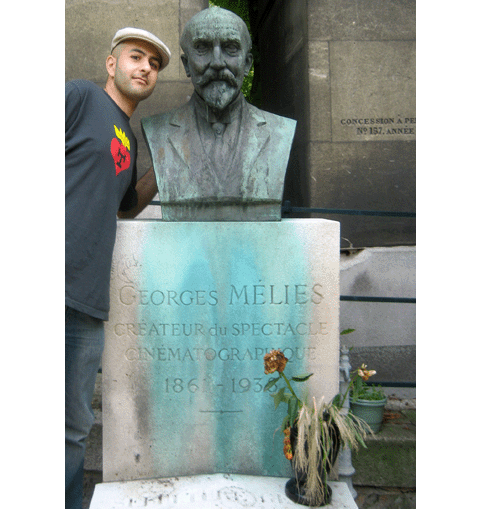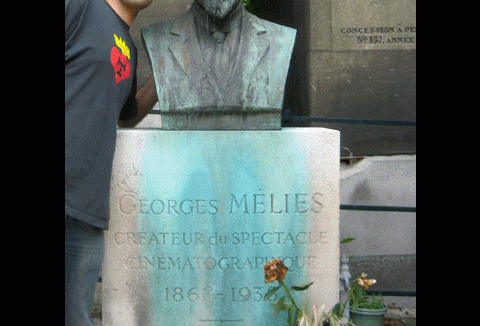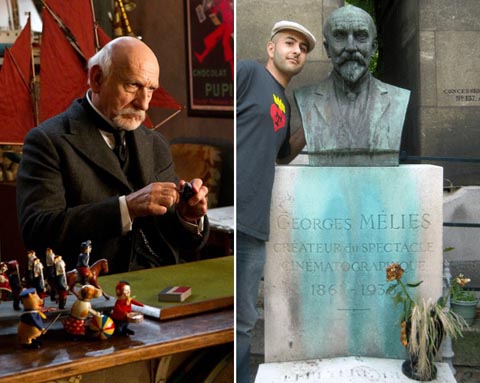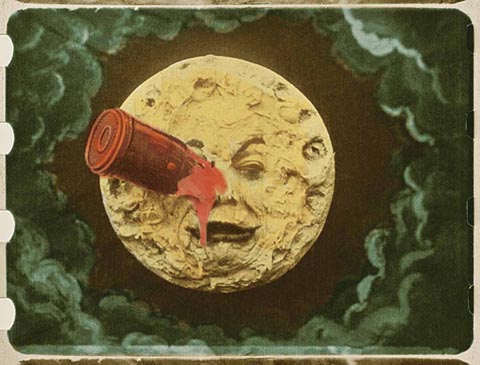

A Few Thoughts on Martin Scorsese’s “Hugo”

Above right is a photo of me in Paris some years ago standing besides the grave of French filmmaker and visual fx pioneer Georges Méliès. I’d heard that Martin Scorsese’s new film Hugo incorporated the character of Méliès (portrayed by Ben Kingsley in the left-hand photo above), but I didn’t anticipate that the entire film would be essentially about him. More broadly, Hugo, which I saw in 3-D last night, is a celebration of filmmaking magic, the medium’s dreamlike possibilities, and true to Scorsese’s personal passions, the importance of film preservation. That Scorsese was able to package these themes into an entertaining family film is nothing short of miraculous.
The film’s strength is its visuals. I got a real kick out of the imagery, from the main setting of the train station and its cogs-and-gears innards to the intricate mechanics of the automaton who figured prominently in the film. The 1930s train station, which provides a warm and intriguing setting for the film, is almost a character in itself, but like most of the film’s characters, it suffers from broad caricature. In this case, it’s the cliched and tiresome American view of Paris, which was also seen in Woody Allen’s recent Midnight in Paris. The film’s freshest visual spectacles were the scenes that recreated Méliès’ films, appropriately so since the film was a celebration of his genius.
The 3-D must be mentioned. It was not offensive–an accomplishment in itself–but as usual, I’m left wondering how much it truly added. The opening shot of the film (was it all CG?), was contributed by ILM I think, and it was a fun use of 3-D in the roller coaster ride sense of the technology. In some of the early scenes, Scorsese showed motes of dust floating around the screen. The fact that I remember that, but not what was happening on the screen doesn’t speak well of the effect. To Scorsese’s credit, it appeared that he cut back on the 3-D trickery midway through the film, mostly recycling 3-D shots used earlier in the film or simply putting it aside in favor of more straightforward storytelling.
Final verdict: Hugo isn’t necessarily a classic, but it is a memorable children’s film with a refreshing lack of cynicism and lofty ideals.
A couple of animation-related notes:
* The film is an adaptation of Brian Selznick’s quasi-graphic novel The Invention of Hugo Cabret. A film based on the book was announced in May, 2008, and was slated to be the live-action directorial debut of Blue Sky co-founder and Ice Age director Chris Wedge. That version, for reasons unknown, was canned.
* A hand-tinted color version of Georges Méliès’s classic “A Trip to the Moon” (1902) was discovered in the 1990s and its restoration was recently completed by French film historian Serge Bromberg of Lobster Films. Bromberg is better known in the animation world as the artistic director of the Annecy International Animated Film Festival.


